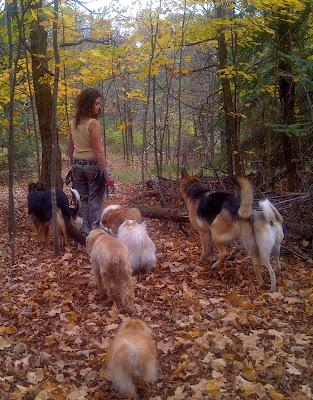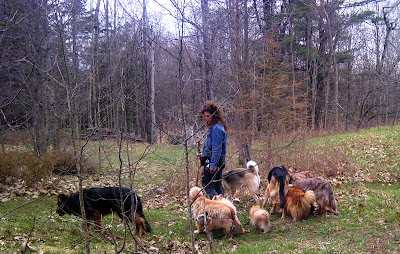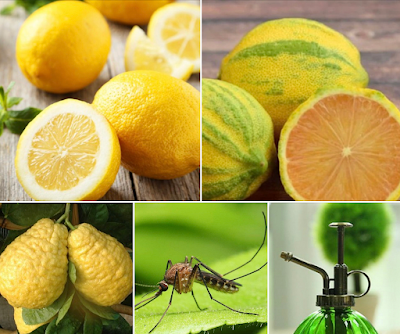Stress, Anxiety, Depression, Aggression in Dogs - Signs, Symptoms, Treatment
 |
| Out for a Walk with Some of My Dogs |
In this article:
- Typical Causes of Stress, Anxiety, Depression, Aggression in Dogs;
- Typical Signs of Stress in Dogs;
- Long-Term Stress is a Health Threatening Condition
- The Use of Conventional Chemical-Based Drugs to Control Stress
- Other Products that Claim to Solve Stress and Anxiety
- Diet Can Create and/or Exacerbate Stress or Help to Alleviate Stress
- Herbs Can Help Too
- Better Communication Helps to Alleviate Stress
A situation that stresses one dog may not affect
another dog and some situations will stress all dogs to one degree or another.
Why the difference? Well, every dog is an individual with his/her own unique disposition,
physical and psychological strengths and weaknesses.
Dogs are subject to the same basic factors that
affect our ability to cope with stress, for example:
- Inherited traits
- Acquired traits
- Diet and nutrition
- Personal health care choices
- Available support structure, etc.
If your dog happens to have heightened sensitivity additional stress may be generated if you are not aware of
and/or do not understand heightened sensitivity. If you have not had the
opportunity to work on your communication skills and your own sense of self
awareness, dealing with your dog’s stress can be very difficult.
1.0 Typical Causes of Stress, Anxiety,
Depression, Aggression in Dogs
Depression, Aggression in Dogs
Dogs can
become stressed for many reasons. The following is a partial list:
- A dog that has heightened sensitivity can become stressed resulting in anxious behaviour if the dog’s human does not learn to be an effective communicator
- An unfamiliar situation
- Vehicle, train, plane
- An unfamiliar environment and movement leading to
- Surgery and injuries
- Under-socialization
- A sudden traumatic event – emotional and/or physical for example
- The passing of a loved one - grief
- The sudden move of a family member away from home
- An emotionally destabilizing encounter reinforced by discomfort of the dog’s human – i.e. an attack by another dog while in a dog park
- A violent thunder storm, wind storm, etc.
- Fireworks, gun shots, etc.
- A condition that is inadvertently created and teaches the dog to be in an altered state of normal, for example:
- Providing affection at the wrong time
- Greeting your dog the wrong way can create separation anxiety, as can:
- Feeling guilty about leaving your dog alone when you go out
- Tension resulting from proximity to animate and inanimate objects – situations and locations, people, other animals, objects associated with tension that creates stress due to fear resulting in avoidance, aggression etc.
- On-leash aggression
- Stress around children
- Stress around other animals
- Stress created by object guarding
- Stress created by guarding of food
- Stress created by guarding of people
- Dietary and Personal health protocol choices matter
- Protect your dog's brain, gut, endocrine and immune system health:
- Highly processed food products harm gut, brain, immune and endocrine health which contributes to and can cause anxiety.
- A quality, species appropriate diet supports gut, brain, endocrine, immune and overall health.
- Conventional insect and parasite prevention products disrupt gut, nervous system, immune and endocrine system health.
- Natural insect and parasite prevention supports overall health.
- Safe home
- A physically safe environment promotes confidence; an inadequate environment promotes stress
- Structure that enables positive, balanced physical and mental output
When parts
of this formula are missing, stress and anxiety are a likely outcome even in
the absence of a sudden trauma.
A
psychologically safe environment in which a dog is understood, properly
directed, provided with structure and both physical and mental stimulation is
stabilizing and helps to build a firm foundation for weathering stressful
situations.
2.0 Typical Signs of Stress in Dogs
A partial list
Appetite
- Loss of appetite
- Refusal to accept offered food or treats
- Diarrhea
Breathing
- Panting
- Rapid breathing
- Stress yawn
- Withheld breath
Body Language
- Facial Expression - tense:
- Eyes
- Diverted eyes will not make eye-contact
- Dilated pupils
- Whale eye
- Tail
- Low to body or tucked between legs
- Ears
- Back
- Head
- Lowered
- Turned to side
- Body
- Low posture
- Weight shift to back legs
- Stress-bow
- Defensive
aggression – barks, growls, bares teeth with fearful body
postures (lowered head, tucked tail, ears back, whale eye) while moving away - Offensive
aggression – barks, growls, bares teeth with offensive body
postures (high tail, direct eye contact, ears erect) while charging/moving forward
Depression
- Lethargy
- Disinterest in activities that the dog would normally look forward to/enjoy
- Loss of appetite
Focus
- Demanding constant attention
- Constant swinging of head or eyes to scan environment or lock on to objects
- On guard looking for threats – defensive and offensive
- Inability to focus or ‘pay attention’
- Fixation
Fur and Skin
- Excessive shedding
- Sudden shedding
- Skin rash from excessive nervous scratching
Mouth
- Drooling and/or foaming at the mouth
- Licking of lips
- Licking of nose
- Excessive licking of paws, legs, etc.
- Excessive licking of another dog or human companion
- Sucking on paws, tail, blankets, etc.
Movement
- ‘Hyper-activity’
- Inability to ‘settle down’
- Restlessness
- Pacing
- Excessive scratching
- Full body shake-off
- Stress-bow
- ‘Suppressed activity’
- Slow and/or ‘slinking’ movement
- Trembling
- Tense and tentative movement
- Avoidance – pulling away, slinking away, running away, hiding, etc.
Vocalization
- Excessive or more than usual
- Barking
- Crying
- Grumbling
- Growling
- Whining, whimpering
3.0 Long-Term (Chronic) Stress is a Health Threatening
Condition
Condition
On a long-term basis stress (psychological
and physical – i.e. dietary insufficiency) can trigger further health issues,
for example:
- Suppression of the immune system - thereby leaving the body more susceptible to:
- Disruption of the endocrine system
- Inflammation
- Infections, such as
- Eye infections
- Ear infections
- Ironically when eye and ear infections are treated with antibiotics (rather than with natural remedies for ears and natural remedies for eyes), greater stress - physical and psychological results due to the fact that:
- Antibiotics kill good bacteria in the GI tract along with bad bacteria
- The elimination of good bacteria destroys the health-giving flora of the GI tract placing additional stress on the immune system and on the psychological state as serotonin levels in the GI tract are also adversely affected
- Insect and parasite infestation;
- When infestation is addressed with chemical-based treatments the immune system and renal system are further taxed due to the active ingredients (toxic pesticides)
- To avoid further taxing the system it is best to use natural topical and ingested treatments such as:
- Fatigue and pain
- Low serotonin levels can adversely affect brain function and behaviour
- Increased vulnerability to viruses
4.0 Conventional Chemical-Based Drugs to Control
Stress and Symptoms
Stress and Symptoms
Chemical-based
anti-depressants such as Reconcile (also known as doggie Prozac, a selective
serotonin reuptake inhibitor – SSRIs) are often prescribed by veterinarians in an attempt to control the symptoms of stress. While SSRIs may
seem to provide some amelioration of symptoms for the short term, SSRIs will
not cure the condition and in many cases may make the situation worse – the
consequences of which can be very serious and can shorten life span. SSRIs
often have severe side effects, may actually mimic some of the symptoms of the
condition being suffered and may become an impediment to actually solving the
root cause of the stress.
You can read more about SSRIs here.
There are many natural, safe ways to safely boost
serotonin levels without putting a dog’s health at risk. In-fact naturally
boosting serotonin levels via diet comes with other very important health
benefits.
Then
there are other symptoms and their ill effects that may need to be addressed.
Symptoms such as hair loss and skin irritation due to excessive licking and
scratching. The use of steroids such as prednisone can cause an additional burden of stress
and further deterioration of health. Consider natural alternatives to steroids and non-steroidal anti-inflammatory drugs
(NSAIDs).
5.0 Other Products that Claim to Resolve Anxiety, Stress
and Symptoms
and Symptoms
The Thundershirt
The Thundershirt is a product that has been aggressively marketed - but is it really the 'solution' to anxiety as claimed by the manufacturer?
I don't think so.
While the Thundershirt may have some value in some circumstances to ameliorate some or a single symptom of anxiety it is not the panacea for cure that is evoked by the product’s labeling as a "proven solution for dog anxiety”.
If you would like to understand more about my thoughts on the Thundershirt you can read here.
Pheramone Collars, Herbal Spray Collars, Bach Flower Essences, Rescue Remedies
Pheromone collars and herbal spray collars are also promoted by some behaviorists, trainers and veterinarians as a solution to anxiety - you can read (in detail) about my thoughts on these products here.
The bottom line - these products may have some value for some dogs to ameliorate symptoms of anxiety but in most cases are not a panacea for curing anxiety.
6.0 Diet Can Create and/or Exacerbate Stress
Diet Can also Help to Alleviate Stress
A poorly designed diet can create
both physical and mental stress on its own or can contribute to an existing
stress from other sources.
Although
many pet food manufactures like to advertise their pet food as: nutritionally
complete, science-based etc. these terms are unregulated.
The manufacturer can
say what they want to without substantiation.
There are many examples of
unsubstantiated if not outright deceitful claims or of negligence by silence exercised
made by pet food manufacturers that include specious if not downright health threatening substances
in their products. And AFFCO certification should not and can not be relied upon as a guarantee of a good dog food. to Ingredients such as:
- ‘Probiotics’ that are non-viable (dead) as the living microbes that make a food probiotic cannot withstand the heat of processing required to make the product – i.e. dry dog food, wet cooked dog food.
- This is, at the very least innocuous, and at worst harmful in the case of those that believe they are meeting their dog’s need for healthy gut flora when in fact no healthy gut support is available from the product;
- Fish meal that contains ethoxyquin, a known: allergen, behaviour problem trigger carcinogen, cause of deformities in puppies, toxin, skin problem trigger, organ failure trigger – you can read about ethoxyquin here;
- High pesticide residue ingredients like corn, soy, canola oil, etc.
- Grains such as rice that are not screened for aflatoxins;
- Artificial food colouring and preservatives;
- Food that is advertised as containing Omega-3, however the amount of Omega-3 included is insufficient;
- No dog food contains sufficient amounts of Omega-3 fatty acids;
- Ingesting an insufficient level of Omega-3 fatty acids has an enormous impact…
- On your dog’s mental health – you can read why here, and;
- On your dog’s physical health – you can read why here;
- Go here for a complete guide on adding Omega-3 fatty acids to your dog's or cat's diet.
It
is very important to understand that no dog food is nutritionally complete on its
own – this includes homemade raw or cooked and commercial processed dry and wet
or raw dog food. It is also why my homemade dog food recipe outlines several basic important supplements to be added to food
at meal time.
There are certain supplements that
are required for each option (homemade or, commercial) in order to make the
diet nutritionally complete and therefore health-supporting and
stress-suppressing.
One more thing in common between
dogs and humans – both species have more serotonin in the gut than in the brain
– when god gut health is not supported behaviour is affected.
A poor diet adds to the creation and
maintenance of stress and anxiety.
7.0 Herbs Can Help Alleviate Stress Too
There are many herbs that can help
to support health and help to alleviate stress - here are a few such examples...
Arnica Montana
Arnica Montana
Lavender
Lemon Balm
8.0 Better Communication Helps to Alleviate Stress
Dogs are very insightful
communicators - much more so than the average human. The significance of this
is huge. Because dogs can sense and discern to a degree that exceeds that of an
untrained human, It does not matter what you say as much as what you
feel.
How you feel at any one given moment
instantaneously transmits itself to:
- Your body in the form of body language
- Facial expression
- How you hold yourself - how one part of your body relates to another part of your body, your posture, etc.
- How you occupy your space
- How you occupy the space you are located in
- Where you are in that space
- How the various parts of your body are positioned in relationship to other parts of your body
- The footprint are you occupying
- How you move, etc.
- How you present yourself
- How you feel and the impacts of that on
- Your breathing
- Your adrenalin level
- Your heart rate
- Your blood pressure
- Your blood sugar
- Your scent
Your thoughts and your emotions
drive your body language.
Whatever
you want your dog to be you must be that thing first. Your thoughts and
emotions provide direction to your dog - more so than the words that you speak. It is not about being the ‘alpha’
a much misused term. It is about directing from a place of pure logic, with insight, fairness, honesty, self-awareness, self-discipline, self-restraint, respect
and true patience. Arguing
with your dog simply serves to create stress for both dog and human. All too
often the human expects the dog to be what the human is not first willing to be
themselves. While at other times it is not that the human is not willing – it is
instead because the human has not had the opportunity to understand how to
direct effectively. When we work to train ourselves what we learn can translate directly in the most positive ways to
our dogs.
It
is important to understand that it is not that we can never feel anxious, depressed,
sad, stressed, fearful around our dogs. It is instead to say that in those moments
when you seek to direct your dog you must do so by first reflecting what it is
that you want your dog to be and your dog will follow your lead.
Never
feel sorry for your dog, never feel guilty as these are destabilizing emotions
to both the dog and the human. Learn how to enable good stress response, and ensure that your thoughts are in
alignment with what you want your dog to feel – this is leading by the right
example.
Article and graphics by Karen Rosenfeld
Holistic Diet, Nutrition, Wellness Services Tailored to Your Individual Dog and Cat
For information about my holistic diet, nutrition, wellness services visit my:
Maintain good health | Address acute and chronic health issues | Pre and post surgery support and recovery
My holistic wellness services are available worldwide via video consultation.
🌎 USA | Canada | UK | Europe | Australia | New Zealand | Asia | South and Central America | Africa | UAE
📱 FaceTime | Facebook | Skype | WhatsApp
Holistic Behavioral Services For Your Dog
For information about my holistic behavioral services visit my:
For dogs of all ages, sizes and breeds
My holistic behavioral services are available locally in-person and worldwide via video session.
🌎 USA | Canada | UK | Europe | Australia | New Zealand | Asia | South and Central America | Africa | UAE
📱 FaceTime | Facebook | Skype | WhatsApp
Affiliations to Companies
✓ None.
✓ I don't sell food or supplements.
✓ I'm not aligned with any companies.
✓ None.
✓ I don't sell food or supplements.
✓ I'm not aligned with any companies.
Article and graphics by Karen Rosenfeld











